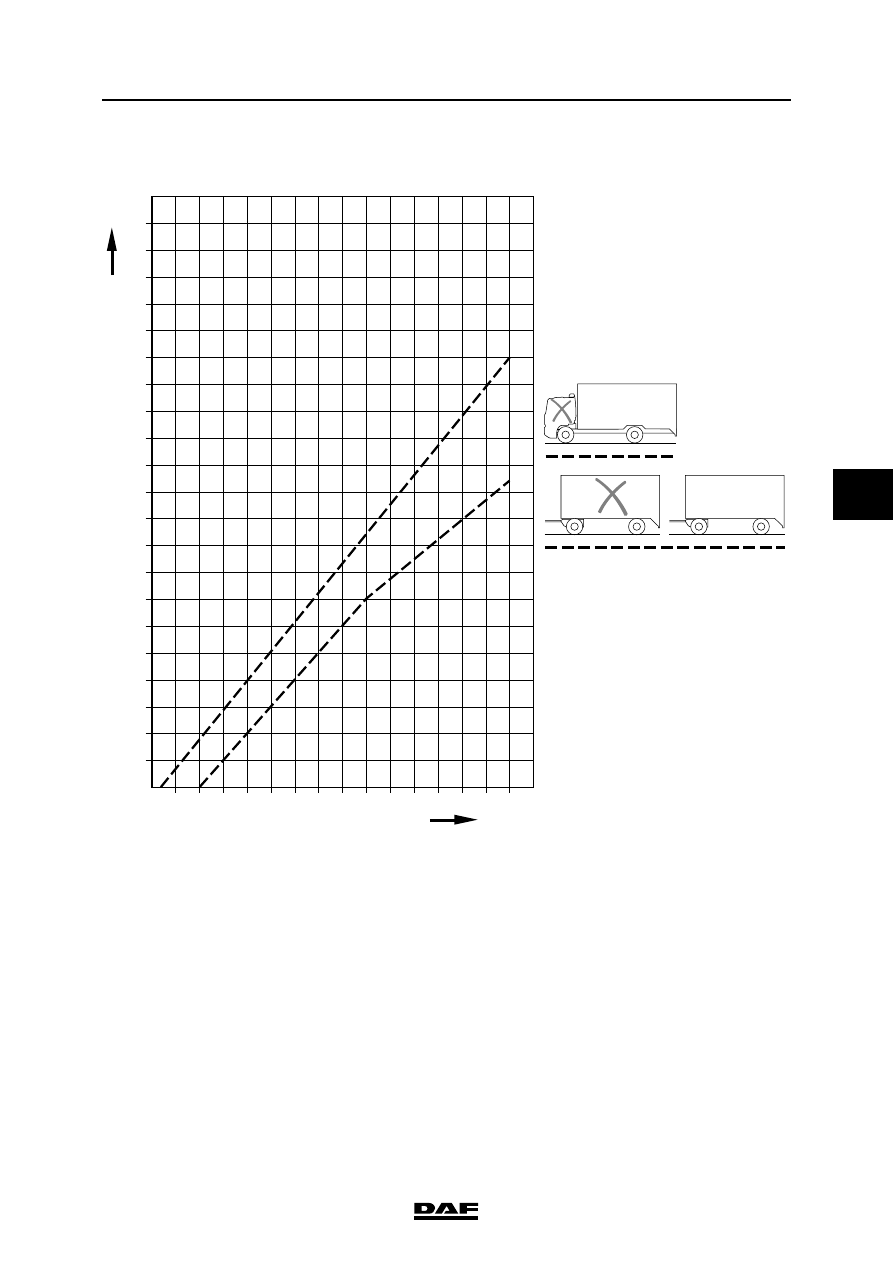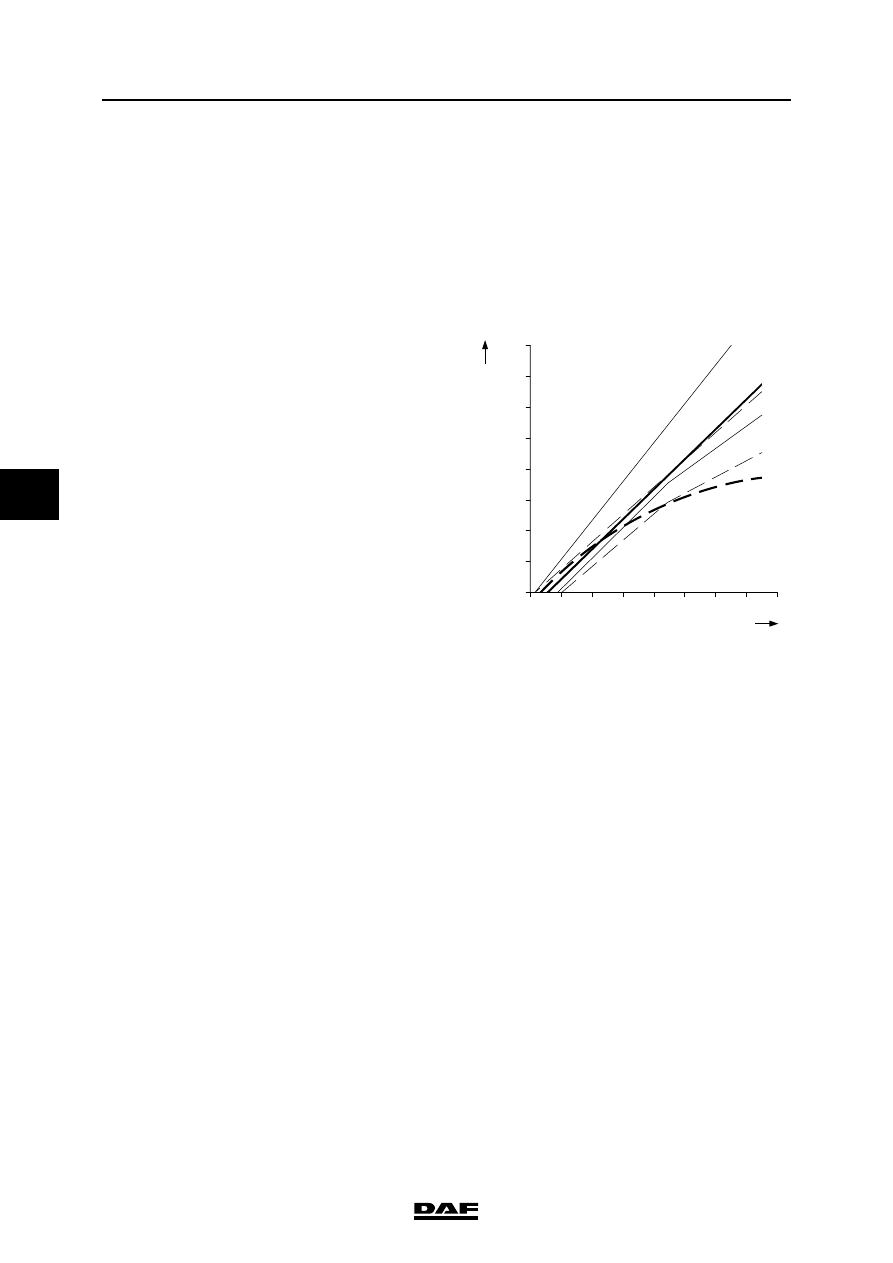DAF LF45, LF55 Series. Manual — part 478

©
200436
1-9
General
BRAKING PERFORMANCE AND BRAKE EQUALISATION
ΛΦ45/55 series
6
5
1.6 EC BAND FOR A LADEN TRUCK/TRAILER COMBINATION
The "EC band" indicates the limits within which
the deceleration value must lie.
The "EC band" applies to:
-
truck with conventional brake system.
-
trailer with conventional or EBS brake
system.
Note:
The following applies to mid-axle trailers fitted
with air brakes:
The permissible ratio between the deceleration
and the pressure at the yellow coupling head of a
laden mid-axle trailer with air brakes should be
within the two areas derived from the EC band for
a laden truck/trailer combination, for which the
vertical scale has been multiplied by 0.95.
100
%
90
80
70
60
50
40
30
20
10
0
1
0
2
3
4
5
6
7
8
R600880
P (bar)
EBS
EBS
a
EBS
BRAKING PERFORMANCE AND BRAKE EQUALISATION
1-10
©
200436
General
5
ΛΦ45/55 series
6
©
200436
2-1
Inspection and adjustment
BRAKING PERFORMANCE AND BRAKE EQUALISATION
ΛΦ45/55 series
6
5
2. INSPECTION AND ADJUSTMENT
2.1 INSPECTING AND ADJUSTING BRAKE EQUALISATION OF NON-EBS
TRUCK WITH NON-EBS TRAILER VEHICLE
Inspecting brake equalisation of non-EBS
truck with non-EBS trailer vehicle
1.
Take a test drive and evaluate the braking
behaviour.
2.
In the case of disc brakes, inspect the
mechanical condition of the brake calliper,
brake disc and brake pads. In the case of
drum brakes, inspect the mechanical
condition of the brake drums and brake
linings. Their condition may provide clues to
the settings that need to be made.
3.
Perform a brake equalisation test using a
brake dynamometer and fill in the "Brake
equalisation form for brake dynamometer".
See "General".
4.
Evaluate the brake equalisation of the
combination using the "EC band graph". The
combination is correctly balanced if the
braking performance at 2 - 3 bar for the truck
and the trailer vehicle are in a comparable
position in the appropriate EC band, i.e. both
in the upper part, both in the lower part or
both in the middle part.
Note:
On a tractor/drawn vehicle combination the
values for the drawn vehicle may be slightly
lower than those for the prime mover. The
deceleration values for the truck and the
drawn vehicle of a truck/trailer combination
should be the same. The reason for this lies
in the dynamic axle load displacement,
which on semi-trailers causes a transfer of
weight to the tractive unit, whereas on
trailers it does not cause a transfer of weight
to the tractive unit.
5.
Due to the adjustment of the brake pressure
advance on the truck and/or trailer vehicle
the deceleration lines in the "EC band graph"
can be affected.
Note:
For optimum interchangeability of vehicles,
the correct choice between these two
alternatives must be made.

BRAKING PERFORMANCE AND BRAKE EQUALISATION
2-2
©
200436
Inspection and adjustment
5
ΛΦ45/55 series
6
6.
If the mechanical condition of the wheel
brakes, the results of the test drive and the
data obtained from the brake equalisation
test using the brake dynamometer give
cause for doing so, the brake pressure
advance of the trailer vehicle control valve
can be adjusted.
Adjusting brake equalisation of non-EBS
truck with non-EBS trailer vehicle
1.
When the brake pressure advance in the
trailer vehicle control valve on the truck is
increased or decreased, the position of the
curve for the trailer vehicle (B) in the graph
will not be affected. This is because the
reference pressures are measured at the
yellow coupling head (= service line). For the
same reason, however, the curve for the
truck (A) will shift to the right or the left (will
appear to be lower or higher respectively).
So the horizontal axis indicates how much
the brake pressure advance has to be
changed. Reducing the brake pressure
advance results in increased deceleration of
the truck. Increasing the brake pressure
advance results in decreased deceleration of
the truck.
Note:
Increasing the brake pressure advance on
the trailer vehicle reaction valve on the trailer
vehicle results in increased deceleration of
the trailer vehicle.
Bear in mind that an increase in the
brake pressure advance does not
necessarily improve the braking
performance of the trailer vehicle. It
only means that the brake pressure
balance between prime mover and
trailer vehicle is changed. Moreover,
in the event of an emergency stop
the poorer braking performance of
the trailer vehicle will again be
noticeable, as the brake pressure
advance is eliminated when the
maximum brake pressure is used.
2.
So the horizontal axis indicates how much
the brake pressure advance has to be
changed.
3.
Take a test run, perform a brake equalisation
test using a brake dynamometer and fill in
the "Brake equalisation form for brake
dynamometer". See "General". If desired or
required, the setting of the trailer vehicle
control valve can be adjusted again.
R600774
0
10
20
30
40
50
60
70
80
a
(%)
A
B
1
2
3
4
5
6
7
8
p(bar)
}

Нет комментариевНе стесняйтесь поделиться с нами вашим ценным мнением.
Текст